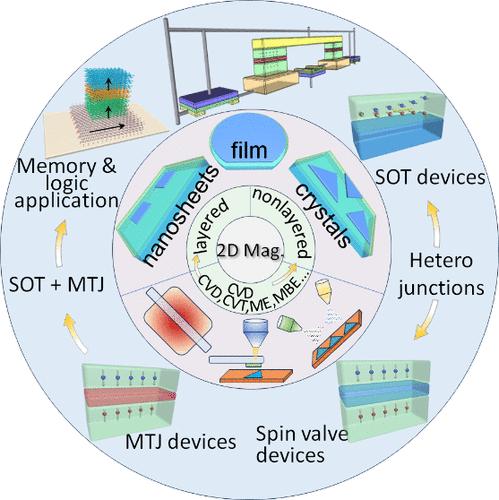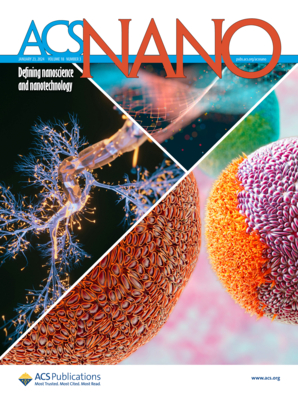Spintronic Devices upon 2D Magnetic Materials and Heterojunctions
IF 16
1区 材料科学
Q1 CHEMISTRY, MULTIDISCIPLINARY
引用次数: 0
Abstract
In spintronics, there has been increasing interest in two-dimensional (2D) magnetic materials. The well-defined layered crystalline structure, interface conditions, and van der Waals stacking of these materials offer advantages for the development of high-performance spintronic devices. Spin–orbit torque (SOT) devices and the tunneling magnetoresistance (TMR) effect based on these materials have emerged as prominent research areas. SOT devices utilizing 2D magnetic materials can efficiently achieve SOT-driven magnetization switching by modulating the interaction between spin and orbital degrees of freedom. Notably, crystal structure symmetry breaking in 2D magnetic heterojunctions leads to field-free perpendicular magnetization switching and an extremely low SOT-driven magnetization switching current density of down to 106 A/cm2. This review provides a comprehensive overview of the construction, measurement, and mechanisms of 2D SOT heterojunctions. The TMR effect observed in 2D materials also exhibits significant potential for various applications. Specifically, the spin-filter effect in layered A-type antiferromagnets has led to giant TMR ratios approaching 19,000%. Here, we review the physical mechanisms underlying the TMR effect, along with the design of high-performance devices such as magnetic tunnel junctions (MTJ) and spin valves. This review summarizes different structural types of 2D heterojunctions and key factors that enhance TMR values. These advanced devices show promising prospects in fields such as magnetic storage. We highlight significant advancements in the integration of 2D materials in SOT, MTJ, and spin valve devices, which offer advantages such as high-density storage capability, low-power computing, and fast data transmission rates for Magnetic Random Access Memory and logic integrated circuits. These advancements are expected to revolutionize future developments in information technology.

二维磁性材料和异质结上的自旋电子器件
在自旋电子学中,人们对二维(2D)磁性材料越来越感兴趣。这些材料的层状晶体结构、界面条件和范德华叠加为高性能自旋电子器件的开发提供了优势。基于这些材料的自旋轨道转矩(SOT)器件和隧道磁阻(TMR)效应已成为研究的热点。利用二维磁性材料的SOT器件可以通过调制自旋自由度和轨道自由度之间的相互作用,有效地实现SOT驱动的磁化开关。值得注意的是,二维磁异质结的晶体结构对称性破缺导致了无场垂直磁化开关和极低的sot驱动磁化开关电流密度,低至106 A/cm2。本文综述了二维SOT异质结的结构、测量和机制。在二维材料中观察到的TMR效应也显示出各种应用的巨大潜力。具体来说,层状a型反铁磁体中的自旋过滤效应导致TMR比接近19000%。在这里,我们回顾了TMR效应的物理机制,以及高性能器件的设计,如磁隧道结(MTJ)和自旋阀。本文综述了二维异质结的不同结构类型和提高TMR值的关键因素。这些先进的器件在磁存储等领域显示出良好的前景。我们强调了在SOT, MTJ和自旋阀器件中集成2D材料的重大进展,这些器件为磁性随机存储器和逻辑集成电路提供了高密度存储能力,低功耗计算和快速数据传输速率等优势。预计这些进步将彻底改变信息技术的未来发展。
本文章由计算机程序翻译,如有差异,请以英文原文为准。
求助全文
约1分钟内获得全文
求助全文
来源期刊

ACS Nano
工程技术-材料科学:综合
CiteScore
26.00
自引率
4.10%
发文量
1627
审稿时长
1.7 months
期刊介绍:
ACS Nano, published monthly, serves as an international forum for comprehensive articles on nanoscience and nanotechnology research at the intersections of chemistry, biology, materials science, physics, and engineering. The journal fosters communication among scientists in these communities, facilitating collaboration, new research opportunities, and advancements through discoveries. ACS Nano covers synthesis, assembly, characterization, theory, and simulation of nanostructures, nanobiotechnology, nanofabrication, methods and tools for nanoscience and nanotechnology, and self- and directed-assembly. Alongside original research articles, it offers thorough reviews, perspectives on cutting-edge research, and discussions envisioning the future of nanoscience and nanotechnology.
 求助内容:
求助内容: 应助结果提醒方式:
应助结果提醒方式:


